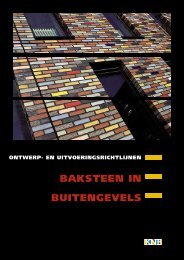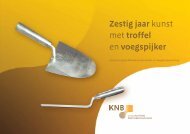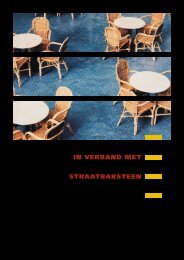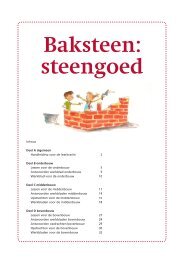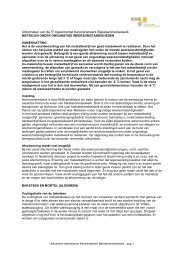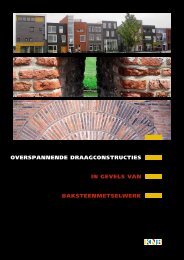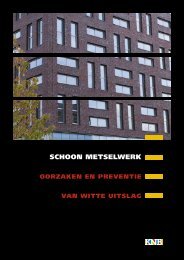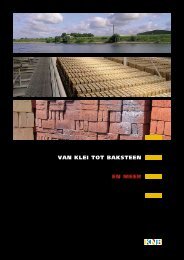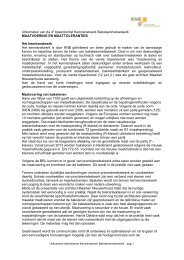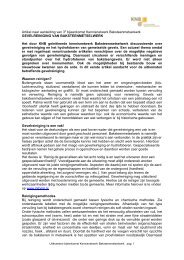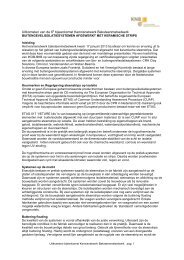"TBE 60th Anniversary" brochure, 2012 - Tiles & Bricks Europe / Home
"TBE 60th Anniversary" brochure, 2012 - Tiles & Bricks Europe / Home
"TBE 60th Anniversary" brochure, 2012 - Tiles & Bricks Europe / Home
You also want an ePaper? Increase the reach of your titles
YUMPU automatically turns print PDFs into web optimized ePapers that Google loves.
60 th Anniversary of<br />
<strong>Tiles</strong> & <strong>Bricks</strong> <strong>Europe</strong><br />
Ceramics, quality for life<br />
<strong>Tiles</strong> & <strong>Bricks</strong> <strong>Europe</strong><br />
<strong>Tiles</strong> & <strong>Bricks</strong> <strong>Europe</strong> aisbl<br />
Rue de la Montagne 17-1000 Brussels<br />
Tel.: +32 2 808 38 80<br />
Fax: +32 2 511 51 74<br />
Website: www.tiles-bricks.eu<br />
60 TH
03 60 th Anniversary of <strong>Tiles</strong> & <strong>Bricks</strong> <strong>Europe</strong> Ceramics, quality for life<br />
© Photographer Sourbron Marc - UZIEN Fotografie<br />
I am proud to celebrate the 60 th anniversary with you<br />
and I am looking forward to <strong>TBE</strong>’s prosperous future<br />
Dr. Heimo Scheuch<br />
<strong>TBE</strong> President<br />
Dear reader,<br />
© Photo: Marcel van der Burg/primabeeld<br />
© Photographer Andrew Smith, SG Photography<br />
I am very glad to present you this<br />
<strong>brochure</strong>, which celebrates the 60 th<br />
anniversary of our <strong>Europe</strong>an association<br />
<strong>TBE</strong> (<strong>Tiles</strong> & <strong>Bricks</strong> <strong>Europe</strong>).<br />
1952 was a remarkable year not only in<br />
the history of <strong>TBE</strong> but also of <strong>Europe</strong>an<br />
integration: the <strong>Europe</strong>an Coal and<br />
Steel Community entered into force on<br />
23 July and the <strong>Europe</strong>an Parliament<br />
Assembly met for the first time on 10<br />
September. On 30 October of the same<br />
year, representatives of the <strong>Europe</strong>an<br />
tile and brick industry met in Zurich and<br />
founded <strong>TBE</strong>. This was the commencement<br />
of a successful history of partnership<br />
throughout our sector.<br />
For 60 years, <strong>TBE</strong> has been operating as a<br />
platform facilitating the dialogue between<br />
our industry and <strong>Europe</strong>an institutions.<br />
Over time, the membership base has<br />
extended significantly, and today it includes<br />
industry associations and companies from<br />
20 <strong>Europe</strong>an Union Member States plus<br />
Croatia, Norway, Russia and Switzerland.<br />
The 60 th anniversary celebrations also<br />
represent an important opportunity to<br />
reflect on the challenges that our industry<br />
will have to tackle in the next decades,<br />
such as sustainable construction, climate<br />
change, resources and energy efficiency.<br />
As you will appreciate in this <strong>brochure</strong>,<br />
our sector is very well positioned in facing<br />
these challenges.<br />
Clay bricks, blocks, roof tiles and pavers<br />
are durable, affordable and provide<br />
comfortable, safe and healthy homes to<br />
millions of people. Furthermore, they<br />
combine traditional architectural heritage<br />
with innovative and future-oriented<br />
construction methods. Last but not least,<br />
clay products offer valuable solutions to<br />
save energy and reduce greenhouse gas<br />
emissions in the building sector.<br />
I am proud to celebrate this 60 th anniversary<br />
with you and I am looking forward to <strong>TBE</strong>’s<br />
prosperous future.<br />
Dr. Heimo Scheuch<br />
<strong>TBE</strong> President<br />
© Photo: Juliusz Sokolowski
04 60 th Anniversary of <strong>Tiles</strong> & <strong>Bricks</strong> <strong>Europe</strong> Ceramics, quality for life<br />
05 60 th Anniversary of <strong>Tiles</strong> & <strong>Bricks</strong> <strong>Europe</strong> Ceramics, quality for life<br />
MEP Karl-Heinz<br />
Florenz<br />
Dr. Johannes Hahn,<br />
Commissioner for Regional Policy<br />
Mr. Ioannis Maliouris<br />
<strong>TBE</strong> Vice-President<br />
<strong>TBE</strong> is a reliable partner of <strong>Europe</strong>an institutions<br />
and other relevant stakeholders<br />
It is very important to<br />
maintain a constructive<br />
dialogue<br />
<strong>Bricks</strong> and roof tiles are<br />
more than merely building<br />
materials<br />
Dear colleague,<br />
With its 60 years of experience, <strong>TBE</strong><br />
is one of the longest-lasting industry<br />
representations in <strong>Europe</strong>. Since the<br />
foundation of the association, brick and<br />
tile manufacturers have considered the<br />
cooperation at <strong>Europe</strong>an level an essential<br />
added value for their business.<br />
Today, <strong>TBE</strong> is a reliable partner of<br />
<strong>Europe</strong>an institutions and other relevant<br />
stakeholders. It offers its members a<br />
valuable platform to exchange information<br />
and best practises in many policy areas,<br />
including sustainability, construction,<br />
climate, energy and standardisation. The<br />
dialogue with policy makers in these<br />
areas helps our industry anticipate the<br />
impact of the regulatory framework on the<br />
competitive position of the sector.<br />
Such cooperation with <strong>Europe</strong>an<br />
institutions is even more important in these<br />
difficult times, as <strong>Europe</strong> is playing a major<br />
role in tackling the current challenges. In<br />
this sense, we warmly welcome the action<br />
plan recently published by the <strong>Europe</strong>an<br />
Commission “Construction: unleashing<br />
the potential of low energy buildings to<br />
restore growth”. This initiative highlights<br />
the relevance of the construction sector in<br />
the <strong>Europe</strong>an economy and acknowledges<br />
it as a driving force for the creation of jobs<br />
and sustained growth. It also foresees<br />
the active involvement of stakeholders in<br />
order to identify a concrete set of measures<br />
aiming at the improvement of investment<br />
conditions.<br />
As they have done in the last 60 years, the<br />
<strong>TBE</strong> members are eager to contribute in<br />
a constructive way to the debate on this<br />
topic as well as on many other subjects.<br />
With this in mind, we are celebrating this<br />
anniversary and we are looking forward to<br />
cooperating with you.<br />
Mr. Ioannis Maliouris<br />
<strong>TBE</strong> Vice-President<br />
On the occasion of the 60 th anniversary<br />
of <strong>TBE</strong>, I am very pleased to host the<br />
stakeholder workshop at the <strong>Europe</strong>an<br />
Parliament. Financing energy-efficient<br />
buildings: how the EU can contribute to<br />
affordable housing<br />
I am also glad to announce that the event<br />
is part of the programme of the 10 th edition<br />
of the <strong>Europe</strong>an Week of Regions and Cities<br />
(OPEN DAYS <strong>2012</strong>). The workshop offers an<br />
interesting opportunity for policy makers<br />
and other relevant stakeholders to discuss<br />
the challenges of affordable and energyefficient<br />
housing. The EU can make a<br />
significant contribution in this area through<br />
a consistent regulatory framework and<br />
better access to financial resources.<br />
Nowadays, the regulatory framework plays<br />
a major role in the competitive position of<br />
<strong>Europe</strong>an companies. For this reason, it is<br />
very important to maintain a constructive<br />
dialogue between representatives of<br />
the <strong>Europe</strong>an institutions and industry<br />
associations. The cooperation with <strong>TBE</strong><br />
for the organisation of the workshop<br />
represents a clear example of this<br />
constructive dialogue and offers a good<br />
opportunity to exchange views on such a<br />
vital subject. Last but not least, I would like<br />
to express my personal compliments to<br />
the <strong>TBE</strong> members for the 60 th anniversary<br />
of the association. I wish you a successful<br />
future.<br />
It is a pleasure for me to hear that this year, the<br />
60 th anniversary General Assembly of <strong>TBE</strong> is<br />
taking place in Brussels, the heart of <strong>Europe</strong>.<br />
<strong>Bricks</strong> and roof tiles are more than merely<br />
building materials. They have made major<br />
contributions to the built environment all over<br />
<strong>Europe</strong> and are – and will continue to be – part of<br />
the <strong>Europe</strong>an cultural heritage.<br />
<strong>Bricks</strong> and roof tiles are made from three<br />
natural elements: clay, fire and water. However,<br />
the sector is constantly stepping up its<br />
commitment to research and to the development<br />
of sustainable building materials and building<br />
solutions, and has committed to supporting<br />
the environmental targets of the EU. Therefore<br />
during the last years enormous efforts have been<br />
undertaken by the sector in order to become<br />
more energy-efficient and less CO 2<br />
intensive.<br />
It is now up to the construction industry and<br />
architects to join forces to develop and build the<br />
new buildings of the future: nearly zero-energy<br />
buildings.<br />
Therefore I would like to highlight the current<br />
regional policy reform and its link with energyefficient<br />
buildings. Best wishes for the <strong>TBE</strong><br />
General Assembly and the 60 th anniversary of<br />
<strong>TBE</strong>.<br />
Dr. Johannes Hahn,<br />
Commissioner for Regional Policy<br />
MEP Karl-Heinz Florenz
06 60 th Anniversary of <strong>Tiles</strong> & <strong>Bricks</strong> <strong>Europe</strong> Ceramics, quality for life<br />
07 60 th Anniversary of <strong>Tiles</strong> & <strong>Bricks</strong> <strong>Europe</strong> Ceramics, quality for life<br />
<strong>TBE</strong> structure<br />
MEP Claude Turmes,<br />
intervening at the <strong>TBE</strong><br />
Stakeholder Workshop<br />
on Near Zero-Energy<br />
Buildings, Brussels,<br />
22 June <strong>2012</strong><br />
General Assembly<br />
Executive Committee<br />
• President<br />
H. Scheuch (AT)<br />
• Vice-President<br />
I. Maliouris (GR)<br />
• Internal auditor<br />
H. Gastinel (FR)<br />
Members<br />
- C. Almeida (PT)<br />
- T. Bisgaard (DK)<br />
- M. Cunial (IT)<br />
- M.E. Gracia Iguacel (ES)<br />
- M. Hadjigavriel (CY)<br />
- P. Jonnard (FR)<br />
- M. Kasa (AT)<br />
- C. Keller (CH)<br />
- G. Koch (AT)<br />
- P. Kolowratnik (AT)<br />
- M. Olbrich (AT)<br />
- M. Oldridge (UK)<br />
- M. Roth (DE)<br />
- F. Terwindt (NL)<br />
- J. Van den Bosche (BE)<br />
<strong>TBE</strong> Secretariat<br />
Secretary General<br />
A. Aiello<br />
<strong>TBE</strong> – a reliable partner<br />
<strong>Tiles</strong> & <strong>Bricks</strong> <strong>Europe</strong> represents industry<br />
associations and companies from 20<br />
<strong>Europe</strong>an Union Member States plus<br />
Croatia, Norway, Russia and Switzerland.<br />
The association promotes the interests of<br />
the clay brick, block, paver and roof tile<br />
industry in <strong>Europe</strong>. It provides a forum<br />
for its members to exchange information<br />
on technical development, sustainable<br />
construction, climate change, resource<br />
efficiency and other emerging issues.<br />
In this way, the association facilitates the<br />
dialogue on these issues within the industry<br />
and between sector representatives and<br />
<strong>Europe</strong>an institutions. The activities are<br />
organised around specialised working<br />
groups of technical experts from national<br />
associations and companies. Members<br />
are regularly informed about upcoming<br />
issues through monthly newsletters. The<br />
association organises public events on the<br />
most relevant subjects for the industry<br />
which are attended by EU officials, trade<br />
associations’ representatives, architects<br />
and other interested stakeholders.<br />
Furthermore, <strong>TBE</strong> is a full member of<br />
Cerame-Unie, the <strong>Europe</strong>an Ceramic<br />
Industry Association. <strong>TBE</strong> also coordinates<br />
the representation of the clay brick and<br />
roof tile industry at the Sustainable<br />
Building Conference. Last but not least, we<br />
collaborate closely with our corresponding<br />
associations in Australia, North America<br />
and South Africa. Our main partners are<br />
the <strong>Europe</strong>an Commission, the <strong>Europe</strong>an<br />
Parliament and the Comité Européen de<br />
Normalisation (CEN).<br />
Product Group Masonry<br />
Chairmanship<br />
M. Kasa (AT)<br />
Housing<br />
Chairmanship<br />
H. Scheuch<br />
(AT)<br />
Regulated Dangerous<br />
Substances (RDS)<br />
Sustainable Construction<br />
Chairmanship<br />
K. Liepach<br />
(DE)<br />
Working Groups<br />
<strong>Europe</strong>an Emission Trading<br />
Scheme (EU-ETS)<br />
Cerame-Unie Secretariat<br />
Product Group Clay Roofing Tile<br />
Chairmanship<br />
M. Cunial (IT)<br />
I. Dorgeret (FR)<br />
Construction Products Regulation (CPR)<br />
Chairmanship<br />
G. Koch<br />
(AT)<br />
Life Cycle Assessment (LCA)<br />
<strong>TBE</strong> stand at the 2011<br />
Sustainable Building<br />
Conference in Helsinki<br />
Thanks to its 60 years of experience, <strong>TBE</strong> is<br />
a reliable partner of <strong>Europe</strong>an institutions<br />
and other relevant stakeholders. Our<br />
members are committed to contribute in a<br />
constructive way to the debate on <strong>Europe</strong>an<br />
policy issues.<br />
Managing Director<br />
R. Batier<br />
Technical and Environmental Director<br />
A. Volckaert<br />
Construction and Sustainability Manager<br />
N. Pargana<br />
Communications Manager<br />
B. Wilhelm<br />
Trade Policy Manager<br />
S. Vackeova<br />
Management Assistant<br />
N. Le Poupon
08 60 th Anniversary of <strong>Tiles</strong> & <strong>Bricks</strong> <strong>Europe</strong> Ceramics, quality for life<br />
09 60 th Anniversary of <strong>Tiles</strong> & <strong>Bricks</strong> <strong>Europe</strong> Ceramics, Quality for life<br />
Clay extraction results<br />
in new nature<br />
“Highly thermal insulating<br />
clay blocks are the ideal<br />
material for the construction<br />
Prof.<br />
Timo Leukefeld,<br />
Germany<br />
© Photo: Kees Hummel<br />
The sector is very well<br />
prepared to tackle the<br />
challenges of the next<br />
decades<br />
A competitive and future-oriented industry<br />
The <strong>Europe</strong>an tile and brick industry<br />
represents more than 700 companies,<br />
from SMEs to large international groups,<br />
which employ around 50,000 people across<br />
<strong>Europe</strong>.<br />
Over the last 60 years, the sector has<br />
invested heavily in product and process<br />
innovations that have revolutioned the<br />
manufacturing process and delivered<br />
modern building solutions.<br />
innovative products that contribute to safe,<br />
comfortable and energy-efficient buildings.<br />
Thanks to these efforts, the industry has<br />
achieved a strong competitive position. As<br />
a result, the sector is very well prepared<br />
to tackle future challenges, namely<br />
sustainable construction, climate change,<br />
resource and energy efficiency.<br />
of energy self-sufficient<br />
houses!”<br />
Timo Leukefeld is professor at several<br />
universities and author of various books on<br />
energy efficiency. Besides he also has his own<br />
company acting as a consultant for energy<br />
self-sufficient buildings. He is also an adviser<br />
for politicians communities and enterprises.<br />
“Our energy self-sufficient house is heated<br />
by the complementary energy from the sun.<br />
The solar energy is stored in a large tank<br />
and a battery for weeks or even months. No<br />
power connection and no more expenses<br />
on oil, gas or electricity are necessary.<br />
Of similar importance is the monolithic<br />
external clay block wall made from special<br />
high-tech clay products that provide<br />
comfortable thermal indoor climate, both<br />
in winter and in summer. The result is a<br />
complete energy autarchy of the building,<br />
without any required energy input from<br />
fossil fuels or electricity from the grid.<br />
Regarding primary energy consumption,<br />
CO 2<br />
output and costs, such a house concept<br />
is 80 per cent better than a standard<br />
passive house and is therefore really a<br />
house of the future based on well-proven<br />
technology.”<br />
This technological progress has profoundly<br />
modified the look of brick and roof tile<br />
plants. Today, kilns are fully automated and<br />
heat recovery systems optimise the overall<br />
energy efficiency. Furthermore, modern<br />
process technology ensures that the<br />
environmental impact is minimal.<br />
New research is looking into those<br />
elements which will shape the plants of<br />
tomorrow, such as alternative sources of<br />
energy, energy efficiency technologies,<br />
recycling of final products, use of recycled<br />
raw materials. At the same time, research<br />
and development is constantly delivering<br />
© Photo: Juliusz Sokolowski
10 60 th Anniversary of <strong>Tiles</strong> & <strong>Bricks</strong> <strong>Europe</strong> Ceramics, quality for life<br />
11 60 th Anniversary of <strong>Tiles</strong> & <strong>Bricks</strong> <strong>Europe</strong> Ceramics, quality for life<br />
The added value of clay building products<br />
02<br />
Contributing to sustainable and<br />
energy-efficient buildings<br />
01<br />
Clay building products<br />
are perfectly suitable<br />
for construction<br />
Durable products delivering comfortable,<br />
safe and healthy homes<br />
In many people’s minds, a brick house is a<br />
goal in life. Indeed, clay building products<br />
are perfectly suitable for construction, as<br />
they are durable and affordable. Firstly,<br />
bricks and roof tiles have an average<br />
lifecycle of over a century. This allows home<br />
owners to easily pass their residence on to<br />
the next generations over time. Secondly,<br />
clay building products require little or<br />
no maintenance and ensure an excellent<br />
thermal insulation. This helps keep the<br />
energy bills low and save money.<br />
All brick buildings are robust and provide<br />
safe shelter. The fire resistance is excellent<br />
as well, as clay products maintain their<br />
properties even at temperatures above<br />
1,000° C. Furthermore, robust clay bricks<br />
and blocks provide resistant solutions in<br />
seismic zones.<br />
A secure home is only the first step towards<br />
healthy and comfortable living. Clean air<br />
is what humans want, and brick buildings<br />
provide it. In western countries people<br />
spend over 90% of their lifetime in closed<br />
rooms. Polluted indoor air and mould can<br />
be a serious issue and healthy buildings<br />
help to prevent it. Due to their mineral<br />
consistency and insulating properties,<br />
clay products are not only 100% VOCfree<br />
but also 100% mould-proof. Finally,<br />
they provide insulation from sound and<br />
vibrations – electric and electrostatic – as<br />
well as ionising radiation, which contributes<br />
to our general wellbeing in daily life.<br />
The industry is constantly<br />
developing<br />
innovative solutions for<br />
sustainable buildings<br />
The building sector represents 40% of the<br />
total energy demand. That explains why<br />
policymakers in the EU are very keen to<br />
hear the contribution from the housing<br />
sector in the battle against climate change.<br />
Clay building products play a major role<br />
in this regard, they provide sustainable<br />
solutions from an environmental, economic<br />
and social point of view.<br />
High thermal insulating clay blocks help<br />
minimise heating and cooling costs, while<br />
roof tiles with photovoltaic cells contribute<br />
to carbon-free energy generation. For this<br />
reason, they are frequently used in lowenergy,<br />
passive and nearly-zero-energy<br />
houses.<br />
Adding brick shield enhances the thermal<br />
performance of buildings. A typical singlefamily<br />
house from 1990 had a common<br />
U-value of 0.50 W/m 2 K. Whilst retaining its<br />
appearance, the cavity is filled and current<br />
installations can easily achieve a U-value of<br />
0.25 W/m 2 K for walls and even 0.14W/m 2 K<br />
for top products. This means a significant<br />
drop in annual energy consumption from<br />
69 to 33 kWh/m² and consequently less CO 2<br />
emissions.<br />
Today, the industry is constantly developing<br />
innovative solutions for energy-efficient<br />
buildings, such as clay façades, which can<br />
reduce the energy consumption of buildings<br />
by 40%.<br />
© Photo: Marcel van der Burg/primabeeld<br />
© Photographer Hervé Abbadi
12 60 th Anniversary of <strong>Tiles</strong> & <strong>Bricks</strong> <strong>Europe</strong> Ceramics, quality for life<br />
13 60 th Anniversary of <strong>Tiles</strong> & <strong>Bricks</strong> <strong>Europe</strong> Ceramics, quality for life<br />
Preserving<br />
architectural heritage<br />
across <strong>Europe</strong><br />
03<br />
04<br />
From traditional to innovative<br />
building solutions<br />
No matter where you reside in <strong>Europe</strong>,<br />
chances are high that a brick plant is<br />
nearby. Over 1,300 production sites are<br />
situated close to quarries all over <strong>Europe</strong><br />
providing local jobs and keeping transport<br />
emissions low. This means that buildings<br />
are frequently constructed with clay from<br />
the local region as bricks travel limited<br />
distances from the quarry to their final<br />
destination.<br />
That explains why our industry understands<br />
and values the regional dimension of the<br />
<strong>Europe</strong>an building tradition. In this regard,<br />
the large variety of shapes, formats and<br />
colours of clay building products helps<br />
preserve the regional architectural heritage<br />
across <strong>Europe</strong>. Furthermore, their long<br />
lifecycle allows for the trans-generational<br />
transfer of this cultural heritage over the<br />
centuries.<br />
Buildings are<br />
frequently constructed<br />
with clay from the<br />
local region<br />
New techniques have<br />
boosted the performance<br />
of clay products<br />
to an outstanding level<br />
5,000 years ago, clay was already used as a<br />
working material. Easy to mix and flexible<br />
to mould, it quickly started playing an<br />
important role in construction. Churches,<br />
town halls and other monuments are only<br />
a few examples of the numerous buildings<br />
that can testify the long durability of clay<br />
bricks, roof tiles and pavers.<br />
Over time, new techniques were developed<br />
that boosted the performance of clay<br />
products to an outstanding level and made<br />
them perfectly suitable to innovative and<br />
future-oriented buildings. Today, clay<br />
bricks, blocks and roof tiles are essential<br />
components in the construction of lowenergy,<br />
passive and nearly-zero-energy<br />
houses or even plus-energy buildings.<br />
The focus of our industry’s research does<br />
not end at the doorstep. Ceramic roof tiles<br />
help recover clean water. Recent studies<br />
have revealed that ceramic roof tiles are<br />
the perfect products to provide goodquality<br />
harvested water thanks to their<br />
hydrophobic coating. Moreover, specially<br />
designed ceramic pavers can be part<br />
of sustainable urban drainage systems<br />
filtering and cleaning rainwater through<br />
geotextile membranes and coarse graded<br />
aggregates.<br />
A long history facilitates building on the<br />
knowledge of the past. Over 100 years<br />
ago recycling deliberately emerged<br />
with Victorian Town Ash on the sites of<br />
coalmines and the idea of re-using other<br />
materials persists to this day. Today,<br />
biogenic sources like sawdust or hay<br />
can be added to create the pores in clay<br />
blocks to increase their thermal insulating<br />
performance. Such innovations result from<br />
the will to provide better buildings for the<br />
world of tomorrow.<br />
© Photographer Andrew Smith, SG Photography
© Photographer Ruud Peijnenburg<br />
14 60 th Anniversary of <strong>Tiles</strong> & <strong>Bricks</strong> <strong>Europe</strong> Ceramics, quality for life<br />
15 60 th Anniversary of <strong>Tiles</strong> & <strong>Bricks</strong> <strong>Europe</strong> Ceramics, Quality for life<br />
“Clay roof tiles are the<br />
number one roofing material<br />
thanks to their technical<br />
characteristics, unique<br />
Piet Jacobs,<br />
Netherlands<br />
President of the International<br />
Federation of Roofing Trade<br />
(IFD)<br />
05<br />
The industry has<br />
invested heavily in<br />
improving the<br />
manufacturing<br />
process<br />
Efficient over the lifecycle<br />
Clay building products provide energy and<br />
resource-efficient solutions in each step of<br />
their lifecycle. Over the last decades, the<br />
industry has invested heavily in improving<br />
the manufacturing process. Early action in<br />
the industry led to a 40% decrease in the<br />
energy required for the production of 1 m²<br />
brick wall in 2007 compared to the 1990s.<br />
Today, the energy consumed in the firing<br />
and drying phase is constantly monitored<br />
in order to ensure the correct temperature<br />
and avoid any wastage. Furthermore,<br />
energy consumption is optimised with<br />
heat-recovery systems, while wastewater<br />
treatment systems avoid any risk of<br />
leakage. Energy and resource efficiency<br />
in the production phase is also achieved<br />
through the use of secondary raw materials<br />
and the lightening of products, such as<br />
slim bricks with -30% weight.<br />
As an extractive industry relying on natural<br />
resources for its raw materials, the brick<br />
and roof tile sector takes the challenge<br />
of biodiversity seriously. In this regard,<br />
quarries and riverbanks are restored and<br />
returned to their natural state during and<br />
after extraction.<br />
The lifecycle of clay products does not<br />
necessarily finish with the already long<br />
life of the building. Clay bricks, blocks and<br />
roof tiles are inert, which makes them<br />
suitable for re-use and recycling. Building<br />
and demolition waste is used extensively<br />
throughout <strong>Europe</strong> for roadwork and as a<br />
secondary aggregate. New research is also<br />
assessing the potential of using ceramic<br />
debris as a raw material component for the<br />
production of clay products.<br />
aesthetics and simple<br />
handling”<br />
Piet Jacobs has been Director and owner of the family business<br />
Jacobs Dakbedekkingen for many years. Today, his son is running<br />
the business. Piet Jacobs is a member of the Dutch federation for<br />
pitched roofs, HHD Het Hellende Dak. He is currently IFD President,<br />
having been elected for the term 2010 to 2013 after which time he<br />
will become the Senior Vice-President for another three years.<br />
IFD is the highest interest group for the roofing trade in the world.<br />
The majority of its members are located in the EU. All full<br />
members and the majority of partners come from small and<br />
medium enterprises (SME).The IFD full members represent 15,500<br />
roofing companies with 135,000 employees<br />
overall and a turnover of about € 11 billion.<br />
Clay roof tiles are well-known for their<br />
durability and stability, and also technically<br />
they have significantly advanced in recent<br />
years. Manufacturers of clay roof tiles and<br />
roofing contractors have collaborated on<br />
holistic solutions for the entire roof through<br />
novel products. These innovations enable<br />
clay roof tiles to create various shapes of<br />
roofs allowing a high degree of individuality<br />
and design. This provides a roofer<br />
numerous possibilities to fully demonstrate<br />
his craftsmanship.<br />
Clay roof tiles are highly desirable and<br />
flexible in use. The wide choice available<br />
from traditional and hand-made tiles<br />
to modern plain and interlocking ones,<br />
provides tailored solutions for both inclined<br />
and low pitched roofs as well as for<br />
facades, in new build and refurbishment.<br />
The development of larger formats with<br />
optimised weight has made roofing<br />
completions easier and quicker. Equally,<br />
significant environmental benefits can<br />
result from this more efficient use of<br />
material. That is why clay roof tiles are<br />
the most requested and most sustainable<br />
product in the roofing sector.
16 60 th Anniversary of <strong>Tiles</strong> & <strong>Bricks</strong> <strong>Europe</strong> Ceramics, quality for life 17 60 th Anniversary of <strong>Tiles</strong> & <strong>Bricks</strong> <strong>Europe</strong> Ceramics, quality for life<br />
60 years of <strong>TBE</strong><br />
President<br />
Vice-President<br />
1952 - 1954 J. Rothéa (F) M.B. Costamagna (F)<br />
1954 - 1956 Dr. M. Risso (I) T. Pierfederici (I)<br />
1956 - 1958 O. Weiss (A) K. von Rosmus (A)<br />
1958 - 1960 Dr. E. Rauch (D) Dr. O. Bott (D)<br />
1960 - 1962 J. von Thiel de Vries (NL) J. Laumans (NL)<br />
1962 - 1964 P. Hartmann (DK) D. Mellbye (N)<br />
1964 - 1966 J. Vigne (F) M. Maury- Laribière (F)<br />
1966 - 1968 G. du Bois d’Enghien (B) J. Verbeeck (B)<br />
1968 - 1970 A.M. Dias Coelho (P) D.M. Megre (P)<br />
1970 - 1973 Dr. L. Ravetta (I) C. Muttoni (I)<br />
1973 - 1976 C. Mumenthaler (CH) P. Binkert (CH)<br />
1976 - 1979 Prof. K. Leitl (A) Dr. H. Gruber (A)<br />
1979 - 1982 A.G.B. King (1979/80) (UK)<br />
D. Jones (1980/82) (UK) D.S. Hartley (UK)<br />
1982 - 1985 E.A. Bäumer (D) E.P. Rauch (D)<br />
1985 - 1988 A. Paloheimo (SF) T. Nilsson (DK)<br />
1988 - 1991 C. Korevaar (NL) J.F.M. Bots (NL)<br />
1991 - 1994 J. Ampe (B) Ch. Dumoulin (B)<br />
1994 - 1996 P.M. Johnson (UK) Ch. Rose, Esq, CBE (UK)<br />
1996 - 1998 Dr. W. Reithofer (A) Dr. E. Schaschl (A)<br />
1998 - 2000 P. Keller (CH) Dr. R. Furler (CH)<br />
2000 - 2002 V. Vitolo (I) Dr. M. Cunial (I)<br />
2002- 2004 C. Damen (NL) H. Gastinel (F)<br />
2004 - 2006 C. Schenck (F) A. Hörmann (D)<br />
2006 - 2008 A. Hörmann (D) H. Scheuch (A)<br />
2008 - 2011 H. Scheuch (A)<br />
2011 - Today H. Scheuch (A) I. Maliouris (G)<br />
On the occasion of the 2 nd International<br />
Congress of the Ceramic Industry,<br />
representatives of the <strong>Europe</strong>an brick and<br />
tile industry met in zurich to discuss the<br />
situation of the industry and exchange<br />
information on best practices.<br />
Considering the success of the event, they<br />
decided to meet two years later in Paris,<br />
where they launched the idea of creating a<br />
<strong>Europe</strong>an association.<br />
The official foundation of <strong>TBE</strong> was<br />
announced at the conference held in<br />
Zurich on 30 and 31 October 1952. At the<br />
same time, Mr. Jean Rothéa (FR) was<br />
unanimously elected as first <strong>TBE</strong> President,<br />
while Mr. Jacques Brossard, who was<br />
then Managing Director of the French<br />
Association, was appointed as <strong>TBE</strong> Director.<br />
The membership covered 12 countries:<br />
Austria, Belgium, Denmark, Finland,<br />
France, Germany, Italy, the Netherlands,<br />
Norway, Sweden, Switzerland and the UK.<br />
They represented 7,000 production plants<br />
and 300,000 employees.<br />
The main activities of the association<br />
included the collection of statistics, the<br />
comparison of test methods and results,<br />
the exchange of technical information and<br />
the promotion of clay building products at<br />
<strong>Europe</strong>an level. One of the major results<br />
was achieved in 1962 with the publication of<br />
a technical dictionary in seven languages.<br />
Over the years, the number of <strong>TBE</strong><br />
members increased significantly, with<br />
the entrance of Portugal (1996), Greece<br />
(1988), Czech Republic (1995), Hungary<br />
and Slovakia (1995), and Poland (1995).<br />
Following this enlargement, the structure<br />
of the association was modified during the<br />
General Assembly in Prague in 1995 in<br />
order to implement simplified procedures<br />
and a faster decision-making process.<br />
Another major step in the history of <strong>TBE</strong><br />
dates back to 18 January 2008, when the<br />
association was officially registered as<br />
an international non-profit organisation<br />
(AISBL) under the Belgian Law. At the<br />
moment, the membership includes 20<br />
<strong>Europe</strong>an Union Member States plus<br />
Croatia, Norway, Russia and Switzerland.<br />
Furthermore, <strong>TBE</strong> is a full member of<br />
Cerame-Unie, the <strong>Europe</strong>an Ceramic<br />
Industry Association.<br />
Mr Jean Rothéa<br />
First president of <strong>TBE</strong><br />
A long history of<br />
successful cooperation
18 60 th Anniversary of <strong>Tiles</strong> & <strong>Bricks</strong> <strong>Europe</strong> Ceramics, quality for life 19 60 th Anniversary of <strong>Tiles</strong> & <strong>Bricks</strong> <strong>Europe</strong> Ceramics, quality for life<br />
Current members of <strong>TBE</strong> (<strong>2012</strong>)<br />
AUSTRIA<br />
BElGIUM<br />
BUlGARIA<br />
President<br />
Gewerke KR Franz Olbrich<br />
President<br />
Mr. Burt Nelissen<br />
President<br />
Dipl.-Ing. Dimitar Georov<br />
UNITED<br />
KINGDOM<br />
FRANCE<br />
NORWAY<br />
DENMARK<br />
NETHERLANDS<br />
GERMANY<br />
BELGIUM<br />
SWITZERLAND<br />
ITALY<br />
SWEDEN<br />
POLAND<br />
CZECH REP.<br />
AUSTRIA<br />
HUNGARY<br />
CROATIA<br />
FINLAND<br />
ESTONIA<br />
LATVIA<br />
BULGARIA<br />
RUSSIA<br />
It is my pleasure to congratulate <strong>TBE</strong> on its<br />
60 th anniversary.<br />
The association of the Austrian brick and<br />
roof tile industry helped found <strong>TBE</strong> 60<br />
years ago and today we are more than ever<br />
convinced that our industry can only solve<br />
the challenges of the future together. We<br />
therefore wish the organisation and its<br />
members all the best for the coming years!<br />
Secretary General<br />
Secretary-General for Austrian affairs:<br />
Dipl.-Ing. Norbert Prommer<br />
Secretary-General for <strong>Europe</strong>an affairs:<br />
Dipl.-Ing. Gerhard Koch<br />
Number of members:<br />
17 companies; 27 factories<br />
Turnover: 160,25 million euro<br />
Number of employees: 878<br />
Name, contact details<br />
Verband Österreichischer Ziegelwerke (VÖZ)<br />
Wienerbergstraße 11, 1100 Wien<br />
Tel.: +43 1 587 33 46-0<br />
Fax: +43 1 587 33 46-11<br />
E-mail: verband@ziegel.at<br />
Website: www.ziegel.at<br />
Founding year: 1950<br />
Member of <strong>TBE</strong> since 1952<br />
Although the brick sector in Belgium<br />
has resisted relatively well in 2011, the<br />
expectations for <strong>2012</strong> remain negative.<br />
Different indicators, such as the number<br />
of building permits, the “construction<br />
barometer”, the order books of architects<br />
and contractors, etc. indicate that the<br />
activities in the building sector will be at a<br />
low level in <strong>2012</strong>.<br />
The “Construction Confederation” is<br />
expecting that less than 40,000 new houses<br />
will be built in <strong>2012</strong>. At the end of 2011,<br />
production decreased due to several<br />
circumstances and at the end of the year<br />
it became obvious that the sector was in a<br />
recession. <strong>2012</strong> will be a particularly difficult<br />
year for all the players in the Belgian sector<br />
of the construction of new buildings.<br />
Secretary General<br />
Mr. Jozef Van Den Bossche<br />
Number of members: 30 companies<br />
Turnover: 330 million euro<br />
Number of employees: 1,600<br />
Name, contact details<br />
Belgische Baksteenfederatie vzw,<br />
Kartuizersstraat 19 b19, 1000 Brussel<br />
Federation Belge de la brique asbl,<br />
rue des Chartreux 19 b19,1000 Bruxelles<br />
Tel.: + 32 2 511 25 81<br />
Fax: + 32 2 513 26 40<br />
E-mail: info@baksteen.be / info@brique.be<br />
Website: www.baksteen.be / www.brique.be<br />
In the deepest crisis our industry has suffered<br />
since the mass privatisation process in the<br />
1990s, it is wonderful to see that a number<br />
of plants are still investing and working hard<br />
towards modernisation and innovation. This<br />
makes me feel optimistic for the post-crisis<br />
period and the competitive power we are going<br />
to have against other industries, as well as<br />
importers.<br />
Number of members:<br />
10 companies<br />
Turnover: 15-18 million euro (estimate)<br />
Number of employees: approx. 700<br />
(estimate)<br />
Name, contact details<br />
9 Balkandji Yovo Str<br />
1612 Sofia<br />
Tel: +359 2 9553455;<br />
Tel: +359 888 595656;<br />
Tel: +359 888 564545<br />
E-mail: ceramic_union@abv.bg<br />
Founding year: 1999<br />
Member of <strong>TBE</strong> since 2011<br />
Founding year: 1947<br />
PORTUGAL<br />
SPAIN<br />
GREECE<br />
Member of <strong>TBE</strong> since 1952<br />
CYPRUS
20 60 th Anniversary of <strong>Tiles</strong> & <strong>Bricks</strong> <strong>Europe</strong> Ceramics, quality for life<br />
21 60 th Anniversary of <strong>Tiles</strong> & <strong>Bricks</strong> <strong>Europe</strong> Ceramics, quality for life<br />
CYPRUS<br />
CzECH REPUBlIC<br />
DENMARK<br />
FINlAND<br />
FRANCE<br />
GERMANY<br />
President<br />
Mr. Antonis Christodoulou<br />
President<br />
Mr. Ing. Jiří Matějka<br />
President<br />
Mr. Jens Piper<br />
President<br />
Dr. Jaakko Raikkonen<br />
President<br />
Mr. Francis lagier<br />
President<br />
Mr. Helmuth Jacobi<br />
Following the expansion of the construction<br />
market we had in Cyprus between 2005 and<br />
2009, unfortunately, the last 2.5 years we<br />
have been facing increasing difficulties. We<br />
have entered a recession period and due to<br />
the major problems faced by the banks in<br />
Cyprus, which are affecting the economy of<br />
the country, and the upcoming measures by<br />
Troika, we believe that our sector will suffer<br />
even more.<br />
Secretary General<br />
Mr. Marios Hadjigavriel<br />
Number of members:<br />
7 companies; 9 factories<br />
Turnover: 18 million euro<br />
Number of employees: 130<br />
Name, contact details<br />
Cyprus Brick & Tile Association<br />
P.O. box 12503<br />
CY-2250 Nicosia<br />
Founding year: 1975<br />
Member of <strong>TBE</strong> since 2009<br />
Currently, the size of the Czech construction<br />
sector is decreasing. In <strong>2012</strong> there was a<br />
decrease in housing construction, including<br />
housing planning, of around 10%. Due to<br />
a lack of support from the state, a further<br />
decrease is expected in the next three years.<br />
As for production capacities, there are<br />
frequent lay-offs due to production surpluses<br />
for burnt bricks, roof tiles and all building<br />
materials in general.<br />
Number of members: 11 companies;<br />
24 factories<br />
Turnover: about 104 million euro<br />
Number of employees: 1,300<br />
Name, contact details<br />
Ing. Jiří Matějka, Nové Homole 61, CZ - 370<br />
01 České Budějovice<br />
Tel.: +420 387 250 609<br />
Fax: +420 387 250 609<br />
Mob.: +420 606 651 102<br />
E-mail: jirimatejka@volny.cz<br />
Website: www.cscm.cz<br />
Founding year: 1993<br />
Member of <strong>TBE</strong> since 1995<br />
We have never recorded a lower activity in the<br />
building & construction industry in Denmark<br />
than during the years 2009 to 2011. When<br />
the private housing sector is doing well, we<br />
are normally also in good shape, but when<br />
the financial situation concerning banks<br />
and building activity levels is as critical as<br />
now – also due to the crisis with the euro –<br />
the sales of houses are seriously reduced.<br />
It seems that in <strong>2012</strong> and 2013 we will also<br />
have to fight this extreme low building activity<br />
on a national level. Six years or more with<br />
low sales is very hard for our industry.<br />
Secretary General<br />
Mr. Tommy Bisgaard<br />
Number of members: 40 companies (in<br />
Denmark, Norway and Sweden); approx. 70<br />
factories<br />
Turnover: 400 million euro<br />
Number of employees: approx. 1,200<br />
Name, contact details<br />
Kalk- og Teglværksforeningen<br />
Nørre Voldgade 48<br />
1358 Copenhagen K<br />
Tel.: +45 33 32 34 34<br />
Fax: +45 51 54 24 54<br />
Fax: +45 33 32 95 78<br />
E-mail: kalktegl@mail.dk<br />
Webiste: www.byg-i-tegl.dk<br />
www.mur-tag.dk<br />
www.taenkitegl.dk<br />
www.tegelinformation.se<br />
ww.byggitegl.no<br />
Founding year: 1893<br />
Member of <strong>TBE</strong> since 1952<br />
The total construction volume in Finland<br />
grew by almost 5 per cent in 2011, says<br />
Jaakko Raikkonen, president of the Finnish<br />
Brick Industry Association. In <strong>2012</strong> the<br />
volume is expected to contract by 2 to 4<br />
per cent. All sectors except renovation of<br />
buildings and civil engineering will shrink<br />
in <strong>2012</strong>.New residential construction picked<br />
up considerably in 2009–2010, after the<br />
recession, partly thanks to stimulation of flat<br />
building and partly due to low interest rates<br />
and the revival of the overall economy. In 2011<br />
some 31,500 dwellings were built, of which<br />
11,000 were single-family homes. Brick is<br />
the most popular façade material in Finland.<br />
The year <strong>2012</strong> looks a little bit gloomy for<br />
new residential construction. The volume<br />
is forecast to contract by a tenth compared<br />
to 2011 partly due to a decrease in the<br />
construction of state-subsidised dwellings.<br />
The biggest challenge in the brick industry<br />
is to achieve a larger share in the market of<br />
façades of single-family homes. The volume<br />
of new non-residential construction increased<br />
by 8 per cent in 2011 following drastic drops<br />
in the two previous years. A slight decline<br />
was registered for <strong>2012</strong>, and the volume will<br />
further diminish in 2013. Brick is also a widely<br />
used material in chimneys and fireplaces in<br />
Finland.<br />
Secretary General<br />
Mr. Juha Luhanka<br />
Number of members: 3 companies;<br />
5 factories<br />
Turnover: 30 million euro<br />
Number of employees: 150<br />
Name, contact details<br />
Finnish Brick Industry Association<br />
c/o Finnish Association of Construction<br />
Product Industries RTT<br />
Mr. Juha Luhanka<br />
P.O. Box 381 (Unioninkatu 14)<br />
FIN-00131 Helsinki<br />
Tel.: +358 50 414 00 84<br />
Fax: +358 9 1299 420<br />
E-mail: juha.luhanka@rakennusteollisuus.fi<br />
Website: www.tiili-info.fi<br />
The housing outlook in France is quite<br />
alarming. Despite 2011 being a rather good<br />
year, housing permits in <strong>2012</strong> have been<br />
decreasing rapidly (- 20% in comparison with<br />
2011), and therefore our industry is worrying<br />
a lot. We are almost back at the levels of the<br />
2009 crisis.<br />
However, we are still confident for the<br />
medium term: the market share of clay<br />
products for use in detached houses has<br />
been constantly growing for the last 5 years.<br />
We have noticed in particular that, for the<br />
first time in 30 years, clay products (both<br />
blocks and bricks) have become the most<br />
widely used construction materials for<br />
building houses. This is due to the wellknown<br />
characteristics of our materials:<br />
aesthetics, health benefits (indoor air<br />
quality), very long service life, thermal<br />
performance and affordability.<br />
Therefore we hope that 2013 and the<br />
following years will bring good news to our<br />
industry.<br />
Secretary General<br />
Mr. Bruno Martinet<br />
Number of members: 96 companies;<br />
149 factories<br />
Turnover: 991 million euro<br />
Number of employees: 5,229<br />
Name, contact details<br />
FFTB<br />
(French Federation for Roof <strong>Tiles</strong> and Blocks)<br />
17, Rue Letellier<br />
75015 Paris<br />
Tel.: + 33 1 44 37 07 22<br />
Website: www.fftb.org<br />
Founding year: 1936<br />
Member of <strong>TBE</strong> since 1952<br />
After nearly 15 years of steady decline after<br />
the reunification of the country, the turnover<br />
of the brick and roof tile industry in Germany<br />
increased by about 15 percent last year. A<br />
slower but hopefully steady improvement of<br />
the situation will take place in the coming<br />
years.<br />
Secretary General<br />
Mr. Martin Roth<br />
Number of members: 80 companies;<br />
120 factories<br />
Turnover: 1.3 billion euro<br />
Number of employees around 9,000<br />
Name, contact details<br />
Bundesverband der Deutschen<br />
Ziegelindustrie e.V.<br />
Schaumburg-Lippe-Straße 4<br />
D-53113 Bonn<br />
Tel.: +49 228 9149318<br />
Fax: +49 228 9149328<br />
E-mail: info@ziegel.de<br />
Website: www.ziegel.de<br />
Founding year: 1897<br />
Member of <strong>TBE</strong> since 1952<br />
Founding year: 1929<br />
Member of <strong>TBE</strong> since 1952
22 60 th Anniversary of <strong>Tiles</strong> & <strong>Bricks</strong> <strong>Europe</strong> Ceramics, quality for life<br />
23 60 th Anniversary of <strong>Tiles</strong> & <strong>Bricks</strong> <strong>Europe</strong> Ceramics, quality for life<br />
Greece<br />
Hungary<br />
ITALY<br />
Netherlands<br />
Poland<br />
Portugal<br />
President<br />
Mr. Ioannis Maliouris<br />
President<br />
Dipl.-Ing. Aladár Kató<br />
President<br />
Arch. Luigi Di Carlantonio<br />
President<br />
Mr. D.K.J. Tommel, Ph.D<br />
President<br />
Mr. Michał Staszewski<br />
President<br />
Mr. Duarte Garcia<br />
The economic crisis which has affected<br />
the entire EU since 2008, and particularly<br />
the southern <strong>Europe</strong>an countries, had as a<br />
result the almost complete destruction of the<br />
productive capacity of the construction sector<br />
(-70% between 2007 and 2011) and therefore<br />
also the ceramics industry in Greece.<br />
A contributing factor in this dramatic fall (or<br />
collapse) is certainly the fact that in previous<br />
periods of growth Greece did not manage<br />
to proceed with well-planned and regulated<br />
activities for the construction industry,<br />
both practically and through the necessary<br />
legislative framework for public and private<br />
projects based on the needs of the country.<br />
Perhaps the only alternative for companies<br />
in the industry is shifting to projects and<br />
seeking opportunities abroad as long as<br />
there is uncertainty about the future, and as<br />
such long-term planning is impossible.<br />
For the future reconstruction of the economy<br />
the keyword is growth. Concrete actions from<br />
the EU to support investment plans will<br />
ultimately revive our industry in order for it<br />
to become competitive again, to create jobs<br />
and to attract new investments. Certainly<br />
the continuous delays in undertaking such<br />
actions on the EU’s political level is simply<br />
postponing the revival of the southern<br />
economies.<br />
Secretary General<br />
Mr. Konstantinos Christodoulidis<br />
Number of members: 30 companies<br />
Turnover: 60 million euro<br />
Number of employees: around 600<br />
Name, contact details<br />
Association of Greek heavy clay industries<br />
Tavaki 4A, PC 57001<br />
Thermi Thessaloniki<br />
Greece<br />
Tel.: + 30 2310489575<br />
E-mail: info@sevk.gr, sevk@otenet.gr<br />
Founding year: 1954<br />
Member of <strong>TBE</strong> since 1988<br />
The construction sector in Hungary is in a<br />
deepening crisis and in 2011 figures dropped<br />
to a particularly low level. The Hungarian brick<br />
manufacturing industry is in an extremely<br />
difficult situation, because its main market,<br />
the construction of new dwellings, has<br />
further shrank compared to the previous<br />
years. In Hungary 1.27 new homes were built<br />
per 1,000 inhabitants in 2011, which is one<br />
of the lowest values in the EU. According to<br />
statistical forecasts, a further drop in this<br />
value is to be expected. The Hungarian brick<br />
manufacturing enterprises are struggling<br />
for economic survival. Companies have had<br />
to significantly cut back their workforce and<br />
close many of their factories. The remaining<br />
factories work well below their capacity. The<br />
Hungarian roof tile manufacturing companies<br />
are in a better position, because in addition to<br />
the construction of new homes, the market of<br />
the renovation of buildings is also significant<br />
for them. Furthermore, they have better<br />
opportunities to export their products.<br />
The development of the housing sector is<br />
of utmost importance for society and the<br />
economy, and it can make a significant<br />
contribution towards achieving ecological<br />
targets (i.e. climate protection through the<br />
improvement of the energy efficiency of<br />
buildings). In order for Hungary to note positive<br />
changes, a predictable governmental housing<br />
policy and the creation of a suitable financing<br />
environment are a must. It is highly important<br />
for Hungary that the resources of the ERDF in<br />
the 2014-2020 EU programming period are<br />
made available to the housing sector (for both<br />
new buildings and renovation).<br />
Secretary General<br />
Ms. Ágnes Ladányi (Executive Manager)<br />
Number of members: 11 companies;<br />
+ 5 companies providing services.<br />
Turnover: 100 million euro (estimate)<br />
Number of employees: approx. 1,000<br />
Name, contact details<br />
Magyar Téglás Szövetség<br />
1092 Budapest, Ráday u. 42-44.<br />
Tel./Fax: +36 1 2017056<br />
E-mail: iroda@teglasszovetseg.hu<br />
Website: www.teglasszovetseg.hu<br />
Founding year: 1995<br />
Over the past five years, the Italian brick<br />
and tile industry has halved its production<br />
levels, which were just above 10 million<br />
tonnes in 2011. Consequently, the number<br />
of companies has also decreased: 170<br />
production sites are still active, while<br />
41 plants are closed or at a standstill.<br />
Unfortunately, the signals for the near future<br />
are not encouraging: a significant drop is<br />
foreseen in <strong>2012</strong> and another one, though<br />
less marked, is expected in 2013. Production<br />
is expected to stabilise only in 2014.<br />
The persistence of such a critical situation<br />
has forced companies to rethink their<br />
strategies, aiming at the optimisation of their<br />
business structures and focusing on highquality<br />
solutions which are in line with the<br />
criteria of sustainability, energy efficiency<br />
and structural safety, with particular<br />
reference to seismic zones.<br />
Therefore, working with associations is<br />
essential for directing decision-making<br />
and organising the consensus among the<br />
different players on the programmes to be<br />
carried out, investment in research and<br />
communication.<br />
Number of members: 95 companies;<br />
125 factories<br />
Turnover: 980 million euro<br />
Number of employees: 6,500<br />
Name, contact details<br />
ANDIL Associazione Nazionale Degli<br />
Industriali dei Laterizi<br />
Via A. Torlonia, 15 – 00161 ROMA<br />
Tel.: +39 06 44236926<br />
Fax: +39 06 44237930<br />
Website: www.laterizio.it<br />
www.solaioinlaterizio.it<br />
www.copertureinlaterizio.it<br />
www.lateriziofacciavista.it<br />
Founding year: 1945<br />
Member of <strong>TBE</strong> since 1952<br />
A pile of bricks is a well-known symbol of<br />
construction. It might also stand for future<br />
challenges. At a time when <strong>Europe</strong>, and<br />
construction in particular, is in a crisis, it is<br />
difficult to imagine that future. Nevertheless,<br />
our industry is thinking about that future<br />
and beyond. The Dutch ceramic industry<br />
has published a roadmap called “Building<br />
Ceramics 2030”. It is a plan, supported by our<br />
entire industry, for the future of the ceramics<br />
process and ceramics products.<br />
It is my strong belief that in <strong>2012</strong> the<br />
Dutch industry is on the verge of new,<br />
more fundamental developments facing<br />
new requirements of sustainability. These<br />
requirements are necessary for the longterm<br />
performance of the buildings of<br />
tomorrow and consequently for the functional<br />
and technical characteristics of the products<br />
and materials from which these buildings<br />
are constructed. The use of single ceramic<br />
building products, like bricks or ceramic<br />
roof tiles, will slowly bring added value to<br />
our production based on the characteristics<br />
of the material in function of its application:<br />
independent, interdependent or in systems.<br />
This trend is marked by the development<br />
of the ceramic building materials into a<br />
multitude of appearances<br />
Today, our industry is ready for tomorrow!<br />
Secretary General<br />
Mr. Ewald L.J. van Hal, LL.W<br />
Number of members: 20 companies<br />
Turnover: 360 million euro<br />
Number of employees: 1,750<br />
Name, contact details<br />
Vereniging Koninklijke Nederlandse<br />
Bouwkeramiek (KNB)<br />
(Royal Association for Building Ceramics)<br />
Florijnweg 6, P.O. Box 153,<br />
NL 6880 AD Velp (Gld.)<br />
Tel.: +31 26 3845 630<br />
Fax: +31 26 3845 631<br />
E-mail: info@knb-keramiek.nl<br />
Website: www.knb-keramiek.nl<br />
Founding year: 1884<br />
Member of <strong>TBE</strong> since 1952<br />
Unfortunately the Polish economy has suffered<br />
a full-scale slowdown this year, which<br />
has impacted the building industry as well.<br />
Furthermore, banks have tightened mortgage<br />
standards, which has resulted in fewer<br />
people willing to buy flats or build houses.<br />
Consequently, the number of building permits<br />
issued in the first seven months of the year<br />
<strong>2012</strong> has decreased by 11% in comparison<br />
with the same period last year.<br />
Unfortunately, there are no indications that<br />
this negative trend in the building market will<br />
be reversed in the coming months. Additionally,<br />
our industry is more and more affected<br />
by the EU’s strict CO 2<br />
emissions regulations,<br />
which may change the financial situation<br />
of producers. Nevertheless, we believe that<br />
ceramics as a building material, which guarantees<br />
comfort of living and is perceived as<br />
an investment-friendly material, will keep its<br />
position in these tough times, and gain new<br />
consumers and a stronger market position. –<br />
Secretary General<br />
Jolanta Kapuścińska<br />
Number of members: 19 companies;<br />
44 factories<br />
Number of employees: approx. 2,000<br />
Name, contact details<br />
ZPCBiS - Employers Union of Building<br />
Ceramics and Calcium Silicates Industry -<br />
Poland<br />
Al. Jerozolimskie 29 / 3<br />
00-508 Warszawa<br />
Tel.: +48 22 826 31 01<br />
Fax: +48 22 826 88 55<br />
E-mail: zwiazek@zwiazek.org.pl<br />
Website: www.zwiazek.org.pl<br />
Founding year 1994<br />
Member of <strong>TBE</strong> since 1995<br />
The Portuguese tiles and bricks sector, like<br />
other construction-related sectors, is facing<br />
a difficult market, which is affecting the activities<br />
of the producing companies, some of<br />
which have even had to close, while others<br />
were forced to reduce their production.<br />
We were not taken by surprise by neither the<br />
crisis nor the consequences! What surprised<br />
us is the dimension of this crisis, in which<br />
many of the factors negatively influencing the<br />
market converged.<br />
The recovery will be difficult and timeconsuming,<br />
and for the surviving companies<br />
many of the habits that have now settled in<br />
will endure: trust, payment terms and credit<br />
are issues that take long to recover from,<br />
and renewed management, innovation and<br />
marketing strategies are needed if the prior<br />
conditions are to be restored.<br />
Still, all this effort from the companies might<br />
not be enough if a solution for the steady<br />
increases in energy costs – which have been<br />
intolerably burdening the production costs of<br />
enterprises – is not achieved.<br />
Secretary General<br />
Mr. José Luís Sequeira<br />
Number of members: 30 companies,<br />
40 factories<br />
Turnover: 95 million euro<br />
Number of employees: 1,325<br />
Name, contact details<br />
APICER - Associação Portuguesa da Indústria<br />
de Cerâmica<br />
Rua Cononel Veiga Simão, Edifício C<br />
3020-053 Coimbra/Portugal<br />
Tel: +351 239497600<br />
Fax: +351 239497601<br />
E-mail: info@apicer.pt<br />
Website: www.apicer.pt<br />
www.ceramica.pt<br />
Founding year: 1996<br />
Member of <strong>TBE</strong> since 1996<br />
Member of <strong>TBE</strong> since 1998
24 60 th Anniversary of <strong>Tiles</strong> & <strong>Bricks</strong> <strong>Europe</strong> Ceramics, quality for life<br />
25 60 th Anniversary of <strong>Tiles</strong> & <strong>Bricks</strong> <strong>Europe</strong> Ceramics, quality for life<br />
Spain<br />
Switzerland<br />
UK - <strong>Bricks</strong><br />
UK - Roof <strong>Tiles</strong><br />
Russia<br />
<strong>TBE</strong> direct members<br />
Belgium - Roof <strong>Tiles</strong><br />
Association des Tuiliers Belges - Koramic<br />
Roofing Products<br />
Courtrai, Belgium<br />
Croatia<br />
Tondach Croatia<br />
Matije Gupca 2, HR 49221 Bedekovcina<br />
Croatia<br />
Wienerberger Ilovac<br />
D. Pokupje 2, HR 47000 Karlovac<br />
President<br />
Dr. José Malpesa<br />
The current situation of the manufacturers<br />
of clay construction products is really<br />
complicated. Since the construction of<br />
new housing has completely stagnated,<br />
the manufacturers have been facing an<br />
unsustainable situation for a long time.<br />
Generally speaking, due to the decline in<br />
the sales of clay construction products<br />
that began in 2008, companies have been<br />
forced to adapt to the market demand.<br />
Consequently, manufacturers are now<br />
concentrating their production in certain<br />
months of the year to avoid overstocking.<br />
This has had a direct impact in other areas,<br />
such as the number of employees, the<br />
turnover, etc.<br />
To face this situation, the industry aims<br />
to remain competitive through innovative<br />
products and systems, by reducing<br />
production costs and by increasing the energy<br />
efficiency in the production plants. Hispalyt<br />
will work to ensure competitiveness and a<br />
high level of environmental commitment.<br />
Secretary General<br />
Dr. Elena Santiago Monedero<br />
Number of members:<br />
200 companies<br />
Turnover: 360 million euro<br />
Number of employees: 9,600<br />
Name, contact details<br />
C/ Orense, 10 - 2ª Planta, Ofic. 13-14<br />
28020 Madrid<br />
Tel.: +34 917 709 480<br />
Fax: +34 917 709 481<br />
E-mail: hispalyt@hispalyt.es<br />
Website: www.hispalyt.es<br />
Founding year: 1968<br />
President<br />
Dr. Peter Burkhalter<br />
The Swiss market has gone through a substantial<br />
restructuring over the past 25 years. The number of<br />
production sites has been reduced to 16 nationwide.<br />
Except for the market leader ZZ Wancor AG, which<br />
is part of the Wienerberger Group, all other brick<br />
factories are family-owned and often also managed<br />
by the owners. In the last 10 years all the mergers<br />
and succession plans have been contemplated locally.<br />
Due to the importance of the transportation costs<br />
the market of the Swiss tile industry remains local.<br />
Thanks to the favourable economic developments in<br />
the Swiss construction industry over the last decade,<br />
our industry has become more sustainable. Some<br />
of our members took advantage of this situation by<br />
renovating and updating their plants and touching new<br />
grounds in the innovation process. These investments<br />
are very important for our industry. With respect to<br />
the general growth of the industry we depend greatly<br />
on the architectural trends in which the roofing tile<br />
market in particular cannot really be increased for new<br />
constructions. In the refurbishment market the roofing<br />
tile market remains very attractive. The industry was<br />
also impacted by the earthquake legislation. A lot of<br />
engineers were not convinced by the earthquake safety<br />
of our ceramic wall products. Therefore, important<br />
efforts have been made and are still being made to<br />
balance this structural challenge. In particular, our<br />
industry has to ensure that we can keep our share in<br />
this competitive market. However, I think that due to<br />
the large-scale renovation of the Swiss building stock<br />
there will be a huge demand for construction in the<br />
next few years, both in terms of refurbishment and<br />
reconstruction. Due to the interesting real estate price<br />
evolutions over the last years local Swiss experts share<br />
the opinion that Switzerland will remain an interesting<br />
market for the real estate and construction industry in<br />
the next decade.<br />
Secretary General<br />
Mr. Ruedi Räss<br />
Number of members: 10 companies;<br />
21 factories<br />
President<br />
Mr. Alan Baxter<br />
The construction market has declined and is<br />
responsible for taking the UK economy into<br />
a double-dip recession. New build activity<br />
continued to grow in 2011 and, overall,<br />
housing output rose by 8%, a modest increase<br />
compared to 2010, when housing output was<br />
25% higher year-on-year. Drastic cuts to the<br />
public sector capital budgets are, however,<br />
starting to have an impact on housing activity<br />
with public-sector starts 14% lower year-onyear<br />
in 2011, whilst output in the public repair,<br />
maintenance and improvement (rm&i) sector<br />
contracted by 8%. With the hoped-for private<br />
sector-led recovery threatened as the economy<br />
struggles to regain momentum, the outlook<br />
for private-sector housing has deteriorated.<br />
In <strong>2012</strong>, private starts are forecast to total<br />
just 104,000, 3% higher than in 2011, before<br />
activity accelerates in 2013. Conditions in the<br />
private housing (rm&i) sector are set to remain<br />
depressed in <strong>2012</strong> with output flatlining as<br />
the subdued economic conditions drag down<br />
activity. A return to growth is anticipated in 2013<br />
with output expanding by 1.7%. The absence<br />
of mortgage availability for the private sector<br />
coupled with companies retaining cash to keep<br />
debt low has hit the construction industry. Most<br />
clay products are sold into housing, and the<br />
difficulty in obtaining finance is balanced by the<br />
critical undersupply of housing. House building<br />
will increase slowly from 2013-14; the growth<br />
for more general construction will depend on<br />
government policy and private initiatives.<br />
Secretary General<br />
Mr. Simon Hay<br />
Number of members<br />
15 companies<br />
Turnover 350 million pound sterling<br />
Number of employees: around 4,000<br />
President<br />
Mr. Alex Patrick-Smith, Managing Director -<br />
Hinton Perry and Davenhill Ltd.<br />
Clay roof tiles have an enduring appeal and<br />
are widely regarded as a premium roofing<br />
product. The UK industry has invested heavily<br />
over recent years to improve production and<br />
energy efficiency with a view to delivering a<br />
truly sustainable product, which has brought<br />
clay tiles to a broader audience. Given the<br />
choice, the superior aesthetic of clay tiles<br />
means specifiers would tend to opt for clay<br />
and this is reflected in the increase seen in<br />
the market share for clay roof tiles in the UK<br />
over the last 15 years.<br />
Secretary General<br />
Mr. Christopher Hall<br />
Number of members: 5 companies,<br />
5 factories<br />
Turnover: 55 million pound sterling<br />
Number of employees: 1,000<br />
Name, contact details<br />
BCC<br />
Federation House<br />
Station Road<br />
Stoke-on-Trent<br />
ST4 2SA<br />
Tel.: +44 1782 744631<br />
Fax: +44 1782 744101<br />
E-mail: chrish@ceramfed.co.uk<br />
Website: www.ceramfed.co.uk<br />
Founding year: 1981<br />
President<br />
Mr. Vladislav Gerashchenko<br />
We integrate the industry for the benefit of<br />
each particular enterprise!<br />
Secretary General<br />
Mr. Peter Hennig<br />
GD of Wienerberger Kirpich<br />
Number of members: 14 companies<br />
Turnover 2011: 8 billion RUR (200 million<br />
euro)<br />
Number of employees: more than 1,000<br />
Name, contact details<br />
APKSM<br />
129085, Russia, Moscow, Prospect Mira, 101, p.1<br />
Tel.: +7495 380 37 14<br />
Fax: +7495 380 37 14<br />
E-mail: apksm@mail.ru<br />
Website: www.apksmrf.ru<br />
Founding year: 2008<br />
Member of <strong>TBE</strong> since <strong>2012</strong><br />
Estonia<br />
Wienerberger Estonia<br />
Kordoni 1, 43401 Aseri<br />
Latvia<br />
Lode AS<br />
Liepas str 1, Liepa parish<br />
Cesu districtx, LV-4128<br />
Norway<br />
Wienerberger Norway<br />
Wienerberger AS, Strengenveien 31, N-3825<br />
Lunde<br />
Sweden<br />
Wienerberger Sweden<br />
Flädie, S-237 91 Bjärred<br />
Number of employees: approx. 560 - 600<br />
Name, contact details<br />
Verband Schweizerische Ziegelindustrie VSZ<br />
Elfenstrasse 19, Postfach<br />
CH-3006 Bern 6<br />
Postfach 371, CH-6210 Sursee<br />
Tel.: +41 31 356 57 57<br />
E-mail: mail@domoterra.ch<br />
Website: www.domoterra.ch<br />
Name, contact details:<br />
The Brick Development Association.<br />
The Building Centre,<br />
26 Store Street, London WC1E 7BT<br />
Tel.: + 44 207 323 7030<br />
Fax: + 44 207 580 3795<br />
E-mail: Brick@brick.org.uk<br />
Website: www.brick.org.uk<br />
Founding year 1946<br />
Founding year: 1891<br />
Member of <strong>TBE</strong> since 2010<br />
Member of <strong>TBE</strong> since 1952
© Photo: Hubaer Kusters © Photographer Verplancke<br />
© Photographer Philippe van Gelooven<br />
© Photo: Verplancke<br />
© Photo: FG + SG/Fernando and Sérgio Guerra



